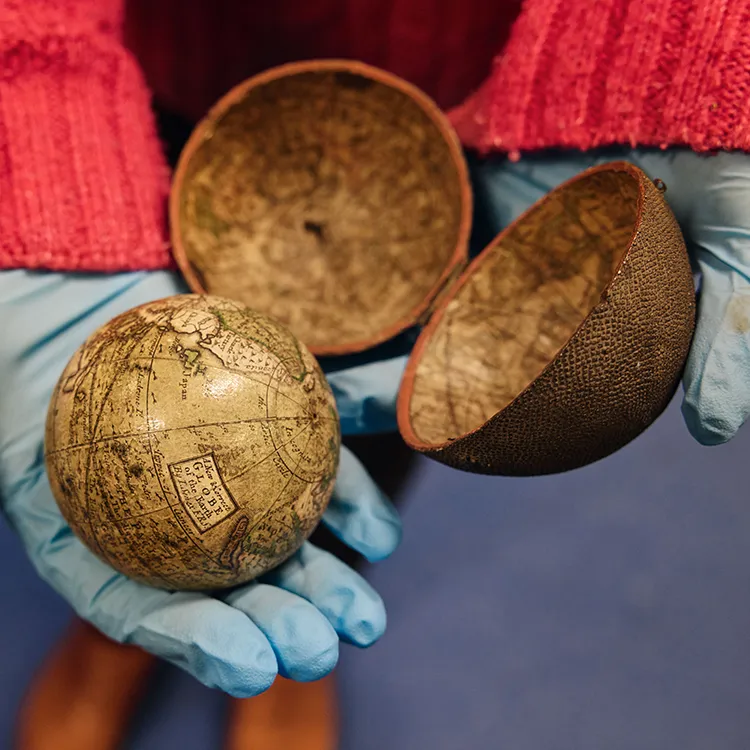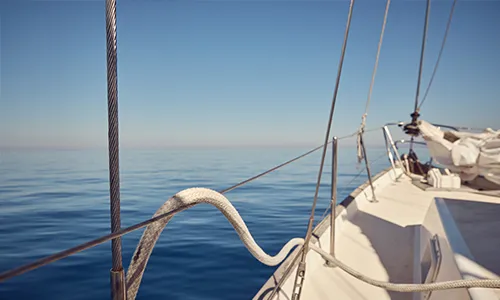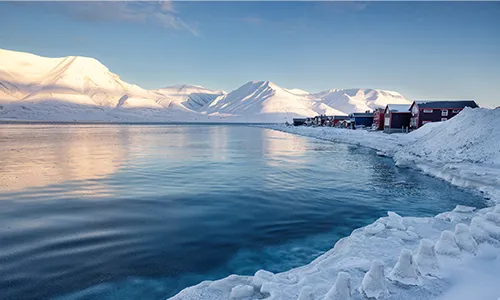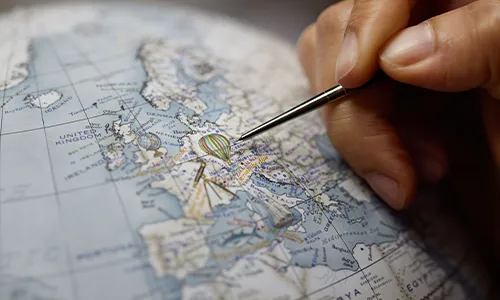All-round success:
The Earth as an artisanal masterpiece

The venerable National Geographic Society financed many expeditions, also the one to Mount Everest in which Tenzing Norgay and Edmund Hillary became the first to ascend the world’s highest peak in 1953.
Katie Parker picks up another exhibit, this time dating back to around 1730 – a hand-illustrated pocket globe resting in a sharkskin bowl. The beautiful little globe depicts the continents, the polar caps, ocean currents and the most important lines of latitude and longitude.
‘Pocket globes used to be very popular,’ says Parker. ‘Unlike two-dimensional maps, they showed us that we’re actually living on a sphere.’
The early globes were particularly special. They showed, for the first time, the planetary scale of our existence. They were a sculptural manifestation of the fact that we are actually racing through space on the back of a blue ball.
The first globes are thought to have appeared 2,000 years ago in ancient Greece, but the Nuremberg Terrestrial Globe is regarded as the world’s oldest preserved specimen. Martin Behaim’s ‘earth apple’, created in 1492, is a jewel of human history, and currently on display at the Germanisches Nationalmuseum in Germany.
Globes fascinate us for another reason, too. They allow us to look at the world in its entirety. Not as an abstraction, but as the real thing, so to speak. We regard the hachured coastlines, the shaded reliefs of the mountains, the blue depths of the oceanic trenches. Here’s the North Pole, there’s the South Pole. The Tropics of Cancer and Capricorn, the Equator. More than any other object, globes have fuelled our desire to travel, have encouraged us to set off for distant shores ourselves.
The first globes are thought to have appeared 2,000 years ago in ancient Greece, but the Nuremberg Terrestrial Globe is regarded as the world’s oldest preserved specimen. Martin Behaim’s ‘earth apple’, created in 1492, is a jewel of human history, and currently on display at the Germanisches Nationalmuseum in Germany.

Globes fascinate us for another reason, too. They allow us to look at the world in its entirety. Not as an abstraction, but as the real thing, so to speak. We regard the hachured coastlines, the shaded reliefs of the mountains, the blue depths of the oceanic trenches. Here’s the North Pole, there’s the South Pole. The Tropics of Cancer and Capricorn, the Equator. More than any other object, globes have fuelled our desire to travel, have encouraged us to set off for distant shores ourselves.

Katie Parker places the beautiful old pocket globe back in its box and closes the archive door. The moment is almost melancholic. The era of old nautical charts and globes has been virtually forgotten, the blank spaces coloured in. When we want to picture the Earth today, we simply zoom in or out on Google Maps. It doesn’t take a minute or cost a cent. No riddles remain.
But London wouldn’t be London or England, if ancient traditions weren’t still cultivated here and there. Like manufacturing symbolic objects such as globes. The world as we like it – a magnificent orb for the living room.

Courage. Perseverance. Enthusiasm
The following morning, a grey Bentley pulls up in Stoke Newington. A 1964 model with a massive bonnet and shabby leather seats. At the wheel, Peter Bellerby, 60, an intrepid tinkerer who has breathed new life into a centuries-old art form. A man who creates worlds almost the way it used to be done. With his own hands. With a paintbrush and glue, with watercolours mixed from honey, ox bile and Arabic gum, using brass and wood and other materials that are difficult to come by.
It all came about quite innocently. Bellerby, who used to work in television, wanted to give his father a globe for his 80th birthday. A beautiful, elegant one with lots of charm. So he went out in search of a globe – in vain. There was nothing suitable to be found. ‘Modern globes are all industrially made, mostly for teaching purposes, without any aesthetic appeal. I certainly didn’t want that.’
Courage. Perseverance. Enthusiasm
The following morning, a grey Bentley pulls up in Stoke Newington. A 1964 model with a massive bonnet and shabby leather seats. At the wheel, Peter Bellerby, 60, an intrepid tinkerer who has breathed new life into a centuries-old art form. A man who creates worlds almost the way it used to be done. With his own hands. With a paintbrush and glue, with watercolours mixed from honey, ox bile and Arabic gum, using brass and wood and other materials that are difficult to come by.
It all came about quite innocently. Bellerby, who used to work in television, wanted to give his father a globe for his 80th birthday. A beautiful, elegant one with lots of charm. So he went out in search of a globe – in vain. There was nothing suitable to be found. ‘Modern globes are all industrially made, mostly for teaching purposes, without any aesthetic appeal. I certainly didn’t want that.’
He researched the subject, visited auctions. Some fine examples did exist, but most of them were either damaged or outrageously expensive. So Bellerby thought: ‘I could build my dad a globe myself!’
That was in the autumn of 2008. Bellerby had no idea what he was in for. He had to learn about astronomy and understand how the Earth worked – its axes, its geometry, its morphology. Very soon, he realized it would be nearly impossible to do what he had in mind. Bellerby did the figures, made calculations, experimented with different types of paper to see what worked best when applied to an orb. And for the map, he had to consider various different projections of the Earth’s surface and decide which to use. It was all very complex. He used a scalpel on the first printed sheets, cutting to within a twentieth of a millimetre. Bellerby thinks it took him 50,000 attempts to get it right.
The questions were endless. Soon, he was spending considerable sums. He studied the history of cartography. How were atlases made? What was the Mercator projection? Bellerby recalls: ‘The whole thing grew into a mammoth project. I took hundreds of wrong turns and scrapped dozens of globes.’
He researched the subject, visited auctions. Some fine examples did exist, but most of them were either damaged or outrageously expensive. So Bellerby thought: ‘I could build my dad a globe myself!’
That was in the autumn of 2008. Bellerby had no idea what he was in for. He had to learn about astronomy and understand how the Earth worked – its axes, its geometry, its morphology. Very soon, he realized it would be nearly impossible to do what he had in mind. Bellerby did the figures, made calculations, experimented with different types of paper to see what worked best when applied to an orb. And for the map, he had to consider various different projections of the Earth’s surface and decide which to use. It was all very complex. He used a scalpel on the first printed sheets, cutting to within a twentieth of a millimetre. Bellerby thinks it took him 50,000 attempts to get it right.

The questions were endless. Soon, he was spending considerable sums. He studied the history of cartography. How were atlases made? What was the Mercator projection? Bellerby recalls: ‘The whole thing grew into a mammoth project. I took hundreds of wrong turns and scrapped dozens of globes.’

His father’s 80th birthday had come and gone. Ultimately, it took Bellerby over two years to finish the globe. His father received his gift when he was 83 – and Bellerby began a journey of his own.
The project grew, and Bellerby plunged into it with a passion. Established a small firm, put together a team of artisans – woodworking specialists, draughters for the maps, precision metal workers to engrave the meridian rings. He rented a studio in north London. One day, a gentleman from Christie’s auction house walked through the door and spotted the globes on the workbench. He said: ‘What a fantastic idea! You should continue. The queue outside your door will stretch to the end of the street.’
Years of exacting work followed. Milling, shaping, figuring. Gluing, painting, drawing. Then back to the beginning and all over again! The globes became increasingly more beautiful and more sophisticated.
The first globe was sold to a librarian in Australia, others were required for a Martin Scorsese film. Then came Bellerby’s breakthrough. Today, Bellerby & Co. are both unique and world-famous. Over the past 15 years, some 5,000 globes have left the manufactory, commissioned by enthusiasts all over the world.
His father’s 80th birthday had come and gone. Ultimately, it took Bellerby over two years to finish the globe. His father received his gift when he was 83 – and Bellerby began a journey of his own.
The project grew, and Bellerby plunged into it with a passion. Established a small firm, put together a team of artisans – woodworking specialists, draughters for the maps, precision metal workers to engrave the meridian rings. He rented a studio in north London. One day, a gentleman from Christie’s auction house walked through the door and spotted the globes on the workbench. He said: ‘What a fantastic idea! You should continue. The queue outside your door will stretch to the end of the street.’
Years of exacting work followed. Milling, shaping, figuring. Gluing, painting, drawing. Then back to the beginning and all over again! The globes became increasingly more beautiful and more sophisticated.
The first globe was sold to a librarian in Australia, others were required for a Martin Scorsese film. Then came Bellerby’s breakthrough. Today, Bellerby & Co. are both unique and world-famous. Over the past 15 years, some 5,000 globes have left the manufactory, commissioned by enthusiasts all over the world.

The London studio is a universe all of its own, an artisans’ realm, a world-maker’s workshop. It smells of plants and fresh coffee – and there’s no sound to be heard. Men and women bend over their workbenches, deeply absorbed in the ancient art of making globes. Boxes of paints, sponges and brushes lie before them on the tables. Not just any brushes, of course, but handmade quill brushes made of the finest squirrel hair.
Globes stand, hang, lie everywhere you look. Small ones, medium ones, big ones that take up half the room. Some are nearly finished, others are bare spheres, still in the process of creation. Lengths of paper hang to dry on clothes lines, colour palettes, knives, cartridges and boxes are stowed on shelves.


Nobody speaks. They’re all cutting and gluing, drawing and colouring. The finished globes don’t have to be good, they have to be perfect. Bellerby & Co., Globemakers is probably the only company worldwide where the Earth is recreated the way it used to be, way back when. Where it is reproduced in such meticulous, almost insane detail.
The small globes are 12 centimetres across, the biggest ones close to 130. The giant Churchill is a floor-standing model, while the Animalia Edition features more than 200 hand-drawn illustrations. In Regency Blue and with a walnut base, it will put you back 74,000 British pounds. The sky is the limit when it comes to the price. It all depends how extravagant a client’s wishes are.
Thirty people are in Peter Bellerby’s employ. Illustrators, draughters, cartographers and painters. Weeks, even months can go by before a globe is completed. Each one is unique. ‘Some clients want a globe that commemorates the biographic details of their lives’, says Bellerby. ‘Where in the world did they live and work? Which countries did they travel to?’ One day, a most unusual commission landed on his desk. The client wanted a globe without country names and without any geographic detail, just a magic blue marble. After flying to the International Space Station as a space tourist, he wanted a globe that reminded him of Earth – bare and beautiful, the way it had looked from space.
Nobody speaks. They’re all cutting and gluing, drawing and colouring. The finished globes don’t have to be good, they have to be perfect. Bellerby & Co., Globemakers is probably the only company worldwide where the Earth is recreated the way it used to be, way back when. Where it is reproduced in such meticulous, almost insane detail.
The small globes are 12 centimetres across, the biggest ones close to 130. The giant Churchill is a floor-standing model, while the Animalia Edition features more than 200 hand-drawn illustrations. In Regency Blue and with a walnut base, it will put you back 74,000 British pounds. The sky is the limit when it comes to the price. It all depends how extravagant a client’s wishes are.
Thirty people are in Peter Bellerby’s employ. Illustrators, draughters, cartographers and painters. Weeks, even months can go by before a globe is completed. Each one is unique. ‘Some clients want a globe that commemorates the biographic details of their lives’, says Bellerby. ‘Where in the world did they live and work? Which countries did they travel to?’ One day, a most unusual commission landed on his desk. The client wanted a globe without country names and without any geographic detail, just a magic blue marble. After flying to the International Space Station as a space tourist, he wanted a globe that reminded him of Earth – bare and beautiful, the way it had looked from space.
You could say that Peter Bellerby and his team are constructing dream worlds, but what they are mostly are actual metaphors for our Earth. The London-made globes set standards and pay tribute to the original, each in their own way. The world as a masterpiece.
An all-round success!


You could say that Peter Bellerby and his team are constructing dream worlds, but what they are mostly are actual metaphors for our Earth. The London-made globes set standards and pay tribute to the original, each in their own way. The world as a masterpiece.
An all-round success!

Author


Photographer


Aluminium Collection
Travel companion

Discover the world with us






















